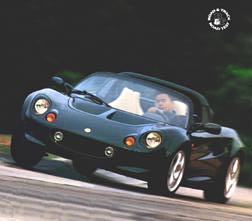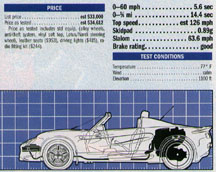Lotus Elise
We test the quintessential sports car that (we hope) is coming to America.

By Sam Mitani
Photos by Guy Spangeberg
You have to drive this car!" exclaimed a European Journalist on a recent trip in Germany. Outside a tavern near Frankfurt, we had been discussing sporty 2-seaters over a bottle of white wine and Monte Cristo cigars when I casually mentioned the Lotus Elise. The stogie nearly shot out of his mouth. "The Elise is an absolutely impressive car," he said after regaining his composure. "What a pity it's not available in America."
Sad but true. Back then, not only was the Elise unavailable in the States but no American journalist had driven one in this country...that is, until a few months ago, when an "informant" notified me that Arnie Johnson, the vice president of sales and marketing at Lotus, had brought one into the country. "Arnie, I must drive the car," I told him over the phone. "I will fly to your headquarters today if I have to."
In less than a week, I found myself in Georgia sitting behind the steering wheel of the Elise, brimming with anticipation (see also "Thrill Rides," August 1997). The car was beautiful, with bulging fenders and a stylish Lotus Europa-like nose highlighted by bold front winglets and distinctive round headlights. The rear is equally stunning, with a small ducktail spoiler above round taillights. Everywhere we went, people flocked around the car, carefully absorbing every inch and often saying in a friendly Southern drawl, "Jeez, that's a nice-lookin' car. Whose is it?"
You can easily see from the photographs that the Elise is a small car, but you don't realize how small it is until you squeeze into the driver's seat: Step over the enormous side sills, suck in your gut, contort your body around the nonadjustable steering wheel, then drop yourself into the bucket seat. The seating position is so low that the doorsill actually doubles as an armrest. But once you're in, the Elise surrounds you with the snugness of a golf glove.
The interior design is simple yet stylishówith classic treatments mixed with contemporary art. The dash is straightforward and features easy-touse ventilation controls and an Alpine stereo system with CD player. The instrument cluster consists of a speedometer and tachometer, with the fuel level, engine temperature and odometer readings set within a liquidcrystal display.
Powering the Elise is Rover's 1.8liter inline-4, mounted amidships, which also sees duty in another nonU.S. car, the MGF (though in the Lotus, it sports an "Elise" cam cover). It produces 118 bhp at 5,500 rpm and delivers 122 lb.-ft. of torque at 3,000ómore than enough to pull the Elise's weight, which, by the way, is an amazingly low 1,635 lb. The engine is mated to Rover's 5-speed manual gearbox shifted through a long lever topped with a beautiful aluminum shift knob.
Turn the ignition key, and the raspy hum of the 4-banger fills the cockpit. Put the shifter into 1st, step on the throttle and the Elise catapults off the line, chirping the rear 205/50R-16 tires. The engine runs out of revs just as the speedometer brushes past the 60 km/h mark. Slam! Second gear is met with a slight crunch and another chirp of the tires, but now the Elise begins to hit its stride. Third gear...4th... 5th...it just keeps gaining momentum.
At the test track, the Elise ran from 0 to 60 mph in 5.6 secondsódecidedly quicker than any of its 2-seat German counterparts and within striking distance of the Ferrari F355 Spider. The Elise reached 100 mph in 17.1 sec. The quarter mile came and went in 14.4. Imagine this car with a stronger engine. (Lotus officials say that the Rover engine is capable of 200 bhp. Also, a small V-6 will fit snugly into the Elise's engine compartment...oh, the possibilities.)

As impressive as the car was on the straightaway, its true home is on a twisty roadóthis is as pure as a sports car gets. The slightest steering input results in an immediate reaction. The car will understeer slightly in sharp turns, but turn-in is crisp and body roll virtually nonexistent. It's the closest thing going to a street-legal go kart.
So what's the secret behind the Elise's extraordinary road-going prowess? The answer lies in its lightweight space frame and structure. Not only does it keep curb weight down, but the use of revolutionary bonding techniques results in exceptional rigidity. The car's chassis is constructed from more than 20 different aluminum extrusions that are specially glued and bolted together forming a single, very solid unit. In fact, you won't find any welds in the Elise's structure. Look for this technique to be used on future Lotus cars, including the Elise coupe and next-generation Esprit.
The Elise comes standard with a not-so-simple-to-erect soft top that does little for the car's appearance (when in place, the car looks as if it's been fitted with a bad toupee). Thankfully, an optional hardtop is available.
Despite the absence of an airbag, and front and rear safety bumpers, the Elise has been designed with safety in mind.
It has excellent side-impact protection, thanks to the oversize side sills and thick aluminum door beams, and the front is protected by various composite materials. Also, the rear of the subframe is steel and has been designed to absorb impact.
After a memorable few days with the Elise, I grudgingly handed the keys back to Arnie, telling him that this car is the Cuban cigar of sports cars: It is one of the world's finest specimens, but can't legally be enjoyed by Americans.
He smiled and winked.
"We're currently working on bringing the Elise to this market," he said. "It'll have to carry a few waivers, of course, but we feel that it can be done. In its current form, something would have to be different on it. Regardless, the Elise may evolve into another car that will be sold in the U.S.; therefore, we hope Americans will get a taste of what this car is all about soon enough. We've got to get this car over here. We'd be crazy not to."
Great news. The Elise is already on my Christmas wish list. And for all enthusiasts who live for a thrill behind the steering wheel, I have only five words: You must drive this car.
In the U.K., the Lotus Elise sells for £20,000 (about $33,000), a remarkably affordable price considering its fun-todrive quotient. This is what the last Elan should have been. It's as if the ghost of Colin Chapman redirected Lotus designers and engineers back on the right path. He would definitely be proud of this car.
Road and Track
September 1997
